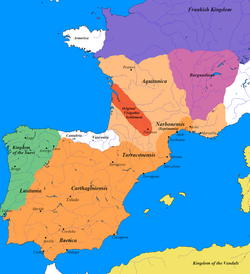Catholic Kingdom of Toledo
|
Kingdom of the Visigoths Regnum Gothorum
| |||||||||||||||
|---|---|---|---|---|---|---|---|---|---|---|---|---|---|---|---|
| 418–c. 720 | |||||||||||||||
 Greatest extent of the Visigothic Kingdom, c. 500 (shown in orange, territory lost after Vouille shown in light orange).
| |||||||||||||||
| Capital |
Toulouse (418-526) Narbonne (526-531) Barcelona (531-542) Toledo (542-725) |
||||||||||||||
| Common languages |
Vulgar Latin Gothic (spoken among elite) |
||||||||||||||
| Religion |
Germanic Paganism (Initially) Chalcedonian Christianity Arianism |
||||||||||||||
| Government | Monarchy | ||||||||||||||
| King | |||||||||||||||
• 418–419 |
Wallia | ||||||||||||||
• 418–451 |
Theodoric I | ||||||||||||||
• 466–484 |
Euric | ||||||||||||||
• 484-507 |
Alaric II | ||||||||||||||
• 511–526 |
Theoderic the Great | ||||||||||||||
• 714–c. 721 |
Ardo | ||||||||||||||
| Establishment | |||||||||||||||
| Area | |||||||||||||||
| 620-710 | 600,000 km2 (230,000 sq mi) | ||||||||||||||
| |||||||||||||||
|
Monarchs of the Iberian Peninsula |
| al-Andalus (taifas) |
| Aragon |
| Asturias |
| Castile |
| Catalonia |
| Galicia |
| Granada |
| León |
| Majorca |
| Navarre |
| Portugal |
|
Spain Medieval · Modern |
| Suebi |
| Valencia |
| Viguera |
| Visigoths |
The Visigothic Kingdom or Kingdom of the Visigoths (Latin: Regnum Gothorum) was a kingdom that occupied what is now southwestern France and the Iberian Peninsula from the 5th to the 8th centuries. One of the Germanic successor states to the Western Roman Empire, it was originally created by the settlement of the Visigoths under King Wallia in the province of Aquitaine in southwest France by the Roman government and then extended by conquest over all of the Iberian Peninsula. The Kingdom maintained independence from the Eastern Roman or Byzantine Empire, the attempts of which to re-establish Roman authority in Iberia were only partially successful and short-lived. The Visigoths were considered as the most civilized among the barbarians, and considered themselves as "heirs of the Roman Empire"; the Goths were the first people to invade Rome and to defeat a Roman emperor in battle. The Visigoths became a Foederati of Rome that wanted to restore the Roman order against the hordes of Vandals, Alans and Suevi. The Roman order fell in 476 A.D.; therefore, the Visigoths had the right to take the territories that Rome had promised in Hispania in exchange for restoring the Roman order.
Sometimes referred to as the regnum Tolosanum or Kingdom of Toulouse after its capital Toulouse in modern historiography, the kingdom lost much of its territory in Gaul to the Franks in the early 6th century, save the narrow coastal strip of Septimania, but the Visigoth control of Iberia was secured by the end of that century with the submission of the Suebi. The kingdom of the 6th and 7th centuries is sometimes called the regnum Toletanum after the new capital of Toledo.
...
Wikipedia

